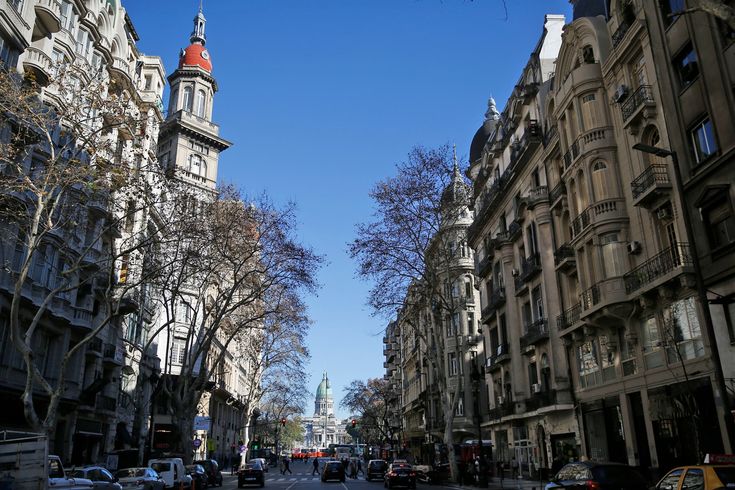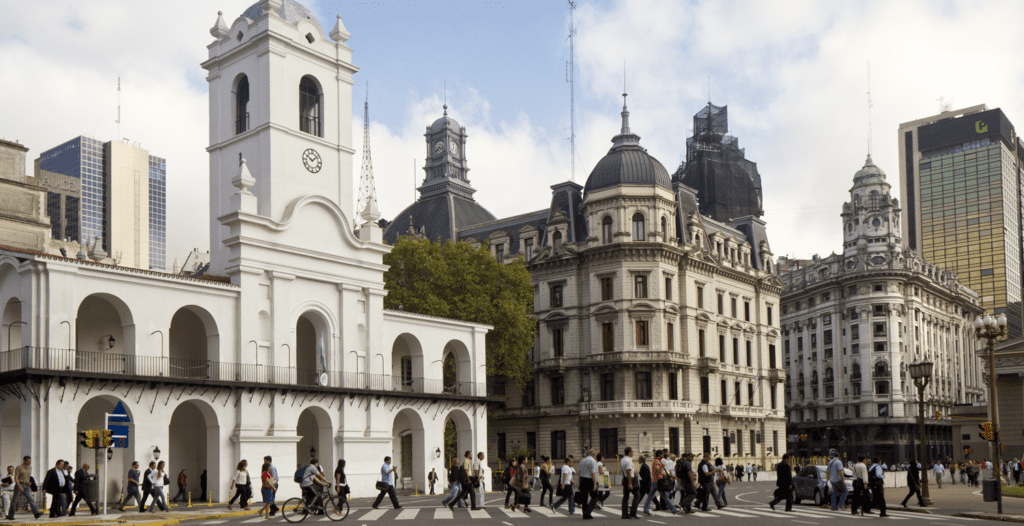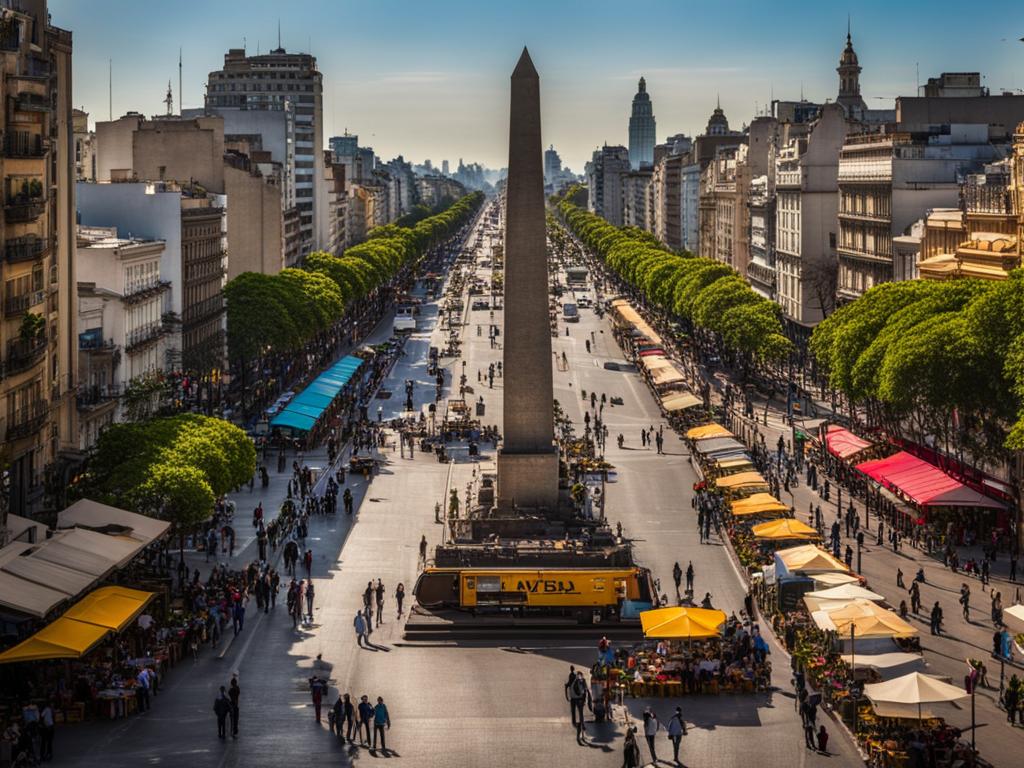Welcome to the expert’s guide to Avenida de Mayo in Buenos Aires! This iconic street is a must-visit destination for anyone exploring the vibrant capital city of Argentina. From its rich history and stunning architecture to its vibrant culture and delicious cuisine, Avenida de Mayo offers a unique and unforgettable experience. Whether you’re a history buff, a foodie, or simply looking to soak up the city’s atmosphere, this travel guide will provide you with all the information you need to make the most of your visit.
Key Takeaways:
- Explore the historic landmarks on Avenida de Mayo, including the iconic Plaza de Mayo and Argentina’s National Congress building.
- Don’t miss the must-see attractions along the avenue, such as Café Tortoni and Plaza de los Dos Congresos.
- Admire the impressive architecture of Avenida de Mayo, from French and Italianate styles to art nouveau and brutalist designs.
- Indulge in the diverse dining and drinking options on Avenida de Mayo, from traditional steakhouse parillas to vegan twists on Argentine cuisine.
- Take the opportunity to explore the surrounding neighborhoods of Palermo, Recoleta, Puerto Madero, and San Telmo for a complete Buenos Aires experience.
Exploring Avenida de Mayo’s Historic Landmarks
Avenida de Mayo, located in the heart of Buenos Aires, is home to many historic landmarks that showcase the rich history and culture of Argentina. Starting at Plaza de Mayo, one of the city’s most iconic squares, you’ll find the pink government palace Casa Rosada, which has become a symbol of Argentine politics. This building holds great historical significance, as it was from its balcony that Eva Perón, the wife of former President Juan Perón, famously addressed the crowds.
Continuing along Avenida de Mayo, you’ll encounter the Cabildo, another important landmark. This colonial-era building served as the seat of the Spanish colonial administration and later became a symbol of resistance during the May Revolution. Today, it houses the National Museum of the Cabildo and the May Revolution, where you can delve deeper into Argentina’s fight for independence.
As you stroll further down the avenue, you’ll come across the Barolo Palace, an architectural masterpiece inspired by Dante’s Divine Comedy. This unique landmark is filled with symbolism and features stunning views of the city from its rooftop lighthouse. Another notable building is the Palacio de las Aguas Corrientes, an enchanting waterworks palace that showcases the city’s water supply history and boasts intricate architectural details.
Table: Historic Landmarks on Avenida de Mayo
| Landmark | Description |
|---|---|
| Plaza de Mayo | The heart of Buenos Aires, home to Casa Rosada and historic political demonstrations. |
| Cabildo | Former seat of the Spanish colonial administration and now a museum showcasing the May Revolution. |
| Barolo Palace | An architectural marvel inspired by Dante’s Divine Comedy, offering panoramic views of the city. |
| Palacio de las Aguas Corrientes | A majestic waterworks palace displaying the history of Buenos Aires’ water supply system. |
Exploring these historic landmarks on Avenida de Mayo provides a fascinating journey through Argentina’s past and allows visitors to appreciate the architectural beauty and cultural heritage of Buenos Aires.
Must-See Attractions on Avenida de Mayo
Avenida de Mayo is not just known for its historic landmarks, but also for its must-see attractions that offer a unique and enriching experience. Whether you’re a history buff, a foodie, or simply looking to immerse yourself in the vibrant culture of Buenos Aires, there is something for everyone to enjoy along this iconic avenue.
One of the top attractions on Avenida de Mayo is the famous Café Tortoni, a historic café that has been a gathering place for intellectuals, artists, and tango enthusiasts since 1858. Step inside and be transported to another era as you sip on a traditional Argentinian coffee and indulge in delicious pastries. Don’t miss the tango performances that take place in the café’s basement, showcasing the soul of Buenos Aires.
As you continue your Avenida de Mayo sightseeing journey, make sure to visit the Plaza de los Dos Congresos, located near the National Congress building. This picturesque square features a stunning statue of two congresswomen, representing Argentina’s commitment to equality and democracy. Take a moment to appreciate the beauty of the statue and the historical significance it holds.
Lastly, as you reach the intersection of Avenida 9 de Julio, be sure to admire the grandeur of the famous fountain, known as the Fuente de las Nereidas or the Fountain of the Nereids. This iconic landmark is a symbol of Buenos Aires and makes for a perfect photo opportunity. Marvel at the intricate details of the fountain and take in the breathtaking views of the city skyline.
Must-See Attractions on Avenida de Mayo:
| Attraction | Description |
|---|---|
| Café Tortoni | A historic café with an old-world charm, known for its tango performances and delicious pastries. |
| Plaza de los Dos Congresos | A picturesque square with a statue of two congresswomen, symbolizing Argentina’s commitment to equality. |
| Fuente de las Nereidas | A famous fountain at the intersection of Avenida 9 de Julio, offering stunning views of the city skyline. |
These attractions on Avenida de Mayo showcase the cultural and architectural richness of Buenos Aires. From the historical significance of Café Tortoni to the symbolic statue in Plaza de los Dos Congresos and the breathtaking views of the Fuente de las Nereidas, each place tells its own story and adds to the overall charm of the avenue.
So, whether you’re a history lover, a food enthusiast, or simply someone who appreciates the beauty of a city’s landmarks, be sure to include these must-see attractions on your Avenida de Mayo itinerary. They are sure to leave you with lasting memories of your time in Buenos Aires.
Exploring Avenida de Mayo’s Architecture
Avenida de Mayo in Buenos Aires is renowned for its impressive architecture, which provides a visual feast for visitors. As you stroll along the avenue, you’ll be surrounded by a stunning array of buildings that reflect the city’s rich history and European influences. From French and Italianate styles to art nouveau and brutalist designs, the architectural diversity on display is truly remarkable.
One notable example of the avenue’s architecture is the Palacio Barolo, an iconic building inspired by Dante’s Inferno. Its intricately designed facade and majestic interior make it a must-see attraction for architecture enthusiasts. Another gem is the Confitería del Molino, a restored coffeehouse that features exquisite art nouveau elements. Its grandeur and attention to detail transport visitors back in time to the golden age of Buenos Aires.
To showcase the architectural wonders of Avenida de Mayo, let’s take a closer look at some remarkable buildings:
Table: Architectural Gems on Avenida de Mayo
| Building | Architectural Style | Notable Features |
|---|---|---|
| Palacio Barolo | Neo-Gothic | Symbolic references to Dante’s Divine Comedy |
| Confitería del Molino | Art Nouveau | Elaborate decorative elements, stained glass windows |
| Casa Rosada | Eclectic | Pink facade, iconic balcony where Evita Perón addressed the crowd |
| Teatro Avenida | Beaux-Arts | Opulent interiors, beautiful ceiling frescoes |
These are just a few examples of the architectural wonders you can discover as you explore Avenida de Mayo. Each building tells a story and adds to the rich tapestry of Buenos Aires’ history and culture. Whether you’re an architecture enthusiast or simply appreciate beautiful design, Avenida de Mayo will captivate you with its stunning array of architectural styles and influences.


Dining and Drinking on Avenida de Mayo
Avenida de Mayo not only offers a rich history and stunning architecture but also a delectable array of dining and drinking options. Whether you’re a meat lover or a vegan, there is something to satisfy every palate along this iconic avenue.
One must-visit spot is La Reverde, a renowned restaurant that specializes in vegan versions of classic Argentine dishes. Indulge in plant-based empanadas, milanesas, and even vegan asado, all bursting with flavors that capture the essence of traditional Argentine cuisine.
If you’re looking for a taste of Porteño nightlife, head over to La Flor de Barracas. This local bar exudes a vintage ambiance and offers live tango shows that will transport you back in time. Sip on a refreshing cocktail while immersing yourself in the vibrant culture of Buenos Aires.
For an authentic taste of Argentine pizza, make your way to La Mezzetta. This Porteño institution has been serving up mouthwatering deep-pan pizzas since the 1930s. Choose from a variety of toppings and savor each cheesy, crispy bite.
Table: Avenida de Mayo’s Dining and Drinking Recommendations
| Restaurant/Bar | Cuisine/Experience |
|---|---|
| La Reverde | Vegan versions of classic Argentine dishes |
| La Flor de Barracas | Live tango shows and vintage ambiance |
| La Mezzetta | Traditional Argentine deep-pan pizzas |
Sightseeing in Avenida de Mayo’s Surrounding Neighborhoods
Avenida de Mayo serves as a fantastic starting point for exploring the vibrant neighborhoods that surround it. Each neighborhood has its own unique charm and offers a different perspective on the city of Buenos Aires. Here are some of the top things to do and see in the surrounding areas:
Palermo
- Explore the trendy bars, boutique shops, and colorful street art in Palermo Soho.
- Relax in the beautiful parks of Palermo, such as the Rosedal and the Japanese Gardens.
- Experience the vibrant nightlife scene with its lively bars, clubs, and live music venues.
Recoleta
- Visit the famous Recoleta Cemetery, the final resting place of Eva Perón and other notable Argentinians.
- Explore the luxurious hotels, art galleries, and high-end boutiques that line the streets of Recoleta.
- Admire the stunning architecture of the Palais de Glace and the Basilica Nuestra Señora del Pilar.
Puerto Madero
- Take a leisurely stroll along the waterfront promenade and enjoy the stunning views of the modern skyscrapers.
- Visit the ecological reserve, Reserva Ecológica Costanera Sur, and explore the nature trails and diverse wildlife.
- Dine at one of the many upscale restaurants offering a fusion of international and Argentine cuisines.
San Telmo
- Wander the cobblestone streets of San Telmo and explore its antique shops and art galleries.
- Experience the rich tango culture with live performances in the neighborhood’s historic milongas.
- Visit the San Telmo Market, a bustling marketplace where you can find everything from fresh produce to unique souvenirs.
Exploring these neighborhoods allows you to discover the diverse charm of Buenos Aires beyond Avenida de Mayo. Each neighborhood offers its own distinct atmosphere, attractions, and experiences, making it a worthwhile addition to your Avenida de Mayo walking tour.


Avenida de Mayo Cultural Experiences
Immerse yourself in the vibrant cultural scene of Avenida de Mayo in Buenos Aires. This iconic avenue is not only known for its historical landmarks and stunning architecture but also for its rich cultural offerings that showcase the city’s artistic spirit.
Art Galleries and Museums
Avenida de Mayo is home to several art galleries and museums that highlight both local and international artistic talent. The Museo de Arte Moderno and Museo de Arte Contemporáneo are must-visit destinations for art enthusiasts, where you can explore a diverse range of contemporary and modern art exhibitions.
For theater lovers, the San Martín Cultural Centre presents a wide variety of performances, ranging from ballet and opera to music concerts. With its modernist architecture and vibrant cultural programs, this venue is a true gem on Avenida de Mayo.
La República de Los Niños
This unique cultural experience is a children’s theme park inspired by Disneyland, offering a whimsical journey through a model city. La República de Los Niños allows both children and adults to immerse themselves in interactive exhibits, educational activities, and entertaining shows. It’s a perfect family-friendly destination that brings joy and wonder to visitors of all ages.
Traditional Tango Shows
No visit to Buenos Aires is complete without experiencing the captivating art of tango. Avenida de Mayo offers numerous tango clubs and venues where you can witness mesmerizing performances by talented dancers. These intimate shows showcase the passion and elegance of this iconic Argentine dance, providing an unforgettable cultural experience.
Whether you’re exploring art galleries, indulging in a whimsical theme park, or immersing yourself in the world of tango, Avenida de Mayo’s cultural experiences will leave you inspired and enriched. Discover the vibrant soul of Buenos Aires through its diverse cultural offerings and create lasting memories in this captivating city.
Exploring Buenos Aires Beyond Avenida de Mayo
While Avenida de Mayo is undoubtedly a highlight of Buenos Aires, there is so much more to discover in this vibrant city. From iconic attractions to cultural experiences and picturesque neighborhoods, Buenos Aires offers a diverse range of experiences that will leave you captivated. Whether you’re a history buff, a food lover, or a fan of the arts, there is something for everyone to enjoy.
Attractions and Landmarks
Buenos Aires is home to numerous attractions that showcase the city’s rich history and architectural beauty. One must-visit destination is the historic neighborhood of La Boca, famous for its brightly colored houses and the iconic Caminito street. Another top attraction is the Teatro Colón, one of the world’s most renowned opera houses, where you can catch breathtaking performances. For nature lovers, a visit to the Buenos Aires Ecological Reserve is a must. This expansive green space offers stunning views of the city skyline and is a perfect escape from the bustling streets.
Cultural Experiences
Immerse yourself in the culture of Buenos Aires by immersing yourself in the city’s vibrant tango scene. Attend a tango show or even take a tango lesson to experience the passion and elegance of this iconic dance. For art enthusiasts, the MALBA (Museum of Latin American Art of Buenos Aires) is a must-visit. It houses a vast collection of contemporary Latin American art and hosts exhibitions by renowned artists from the region. Another cultural gem is the Evita Museum, dedicated to the life and legacy of Eva Perón, a beloved figure in Argentine history.
Neighborhood Exploration
Beyond Avenida de Mayo, Buenos Aires is made up of diverse and charming neighborhoods that offer unique experiences. Recoleta is known for its exquisite architecture and the famous Recoleta Cemetery, where you can find the tomb of Eva Perón. Palermo, on the other hand, is a trendy and eclectic neighborhood with bustling streets lined with vibrant street art, boutique shops, and an array of cafes and nightlife options. San Telmo, the oldest neighborhood in Buenos Aires, is a bohemian enclave filled with tango clubs, antique stores, and cobblestone streets, exuding a nostalgic charm.
| Attraction | Description |
|---|---|
| La Boca | A historic neighborhood famous for its colorful houses and tango culture. |
| Teatro Colón | One of the world’s most renowned opera houses, known for its stunning architecture and world-class performances. |
| Buenos Aires Ecological Reserve | A natural oasis in the heart of the city, offering walking trails and panoramic views of the skyline. |
| MALBA | The Museum of Latin American Art of Buenos Aires, showcasing contemporary Latin American art. |
| Evita Museum | A museum dedicated to the life and legacy of Eva Perón, a prominent figure in Argentine history. |
Exploring Buenos Aires beyond Avenida de Mayo opens up a world of possibilities. Each neighborhood has its own unique character, offering a different perspective on the city. Whether you’re admiring the colorful houses of La Boca, immersing yourself in the tango culture of San Telmo, or exploring the modern art scene in Palermo, you’ll discover the true essence of Buenos Aires. So go beyond the iconic avenue and let the vibrant streets of Buenos Aires unveil their secrets to you.


Conclusion
Exploring Avenida de Mayo in Buenos Aires is an essential part of any visit to the city. With its rich history, stunning architecture, vibrant culture, and delectable cuisine, this iconic avenue offers a myriad of experiences for travelers. Whether you’re marveling at the historic landmarks, immersing yourself in the local culture, or simply enjoying a leisurely stroll, Avenida de Mayo has something to captivate every visitor.
To make the most of your trip to Buenos Aires, here are a few travel tips. Firstly, consider visiting Avenida de Mayo on weekends when there is less traffic, allowing you to fully appreciate the avenue’s charm. Secondly, don’t miss the chance to explore the surrounding neighborhoods, such as Palermo, Recoleta, Puerto Madero, and San Telmo, each offering its own unique atmosphere and attractions. Lastly, indulge in the city’s culinary delights by sampling the diverse dining options along Avenida de Mayo, from traditional Argentine steakhouses to vegan twists on local cuisine.
As you bid farewell to Avenida de Mayo and Buenos Aires, take with you the memories of the beautiful architecture, the vibrant tango performances, the mouthwatering cuisine, and the warm hospitality of the city’s residents. Buenos Aires is a destination that leaves a lasting impression, and Avenida de Mayo is just the beginning of your exploration of this captivating city. So, pack your bags, embrace the energy of Buenos Aires, and embark on a journey filled with unforgettable moments.




